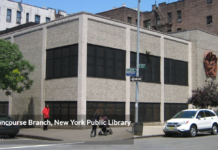A report by the Center for an Urban Future (CUF) says infrastructure projects for libraries and cultural institutions managed by the Department of Design and Construction (DDC), the city’s chief capital construction agency, take much longer to complete and cost significantly more than similar capital projects that are managed by the institutions themselves or overseen by other governmental agencies.
“Our report features an analysis conducted by the Citizens Budget Commission (CBC) of 144 DDC-managed capital projects at cultural institutions and libraries from fiscal years 2010 to 2014,” the document from the non-profit research agency says.
“The findings are troubling. The median capital project in our analysis took more than four years to complete, and 1 lasted for more than seven years. Meanwhile, the median cost for new buildings in our sample was a staggering $930 per sq. ft.—roughly double the cost of new office space in the city.”
Beyond the data, we conducted dozens of interviews with top officials at cultural institutions and libraries, as well as architects, private construction managers, engineers, and even officials at DDC. These conversations depict a city nonprofit capital design and construction process that is badly in need of reform.
CUF says it teamed up with the CBC to analyze timelines and cost breakdowns for 144 library and cultural capital projects completed between fiscal years 2010 and 2014. These projects constitute approximately one-quarter of all library and cultural projects completed during the Bloomberg administration, and all of the DDC-managed library and cultural projects completed during these five years.
The CUF report indicates construction costs for libraries and cultural institutions at $900 per sq. ft. are significantly higher than private sector costs in NYC.
Both the interviews and financial analysis brought us to the same conclusion: City-managed capital projects for nonprofit organizations take way too long and cost significantly more than they should.
To begin with, the projects we analyzed took staggeringly long to finish. The median project took 1,550 days—more than four years—to complete. However, 36 percent of the projects took more than five years, and several lasted more than a decade. The durations are especially shocking given that most projects were relatively small and involved the replacement or renovation of isolated building components such as mechanical equipment, facades, and roofs.
Of all the library and cultural capital projects we analyzed, the ones that involved new construction took the longest to complete—nearly seven years, or 2,467 days. But fairly routine maintenance projects also take years to finish. When broken down by project type, the median mechanical system upgrade—a category that includes the replacement and installation of fire alarms, boilers, and heating/cooling systems— took 1,573 days (4.3 years) until completion.
As an example, CUF says a group of fire-safety projects at the New York Public Library (NYPL) took only three months to build and install but spent 1,499 days in the planning and approval phases before construction could even begin.
One relatively small parapet reconstruction project at the Brownsville branch of the Brooklyn Public Library (BPL) got so bogged down by the many layers of approval—not just at the Office of Management and Budget (OMB) but at the Fire Department, Department of Buildings, and the Public Design Commission—that it took 1,453 days before construction started, and spanned 2,022 days (over 5.5 years) from the time the project file was opened at DDC until it was deemed substantially complete.
Likewise, construction costs were extremely high. Relying on DDC’s cost estimates, the median cost of construction for the new library and cultural buildings in our sample was an astronomical $930 per sq. ft.
This is strikingly high, even in a city with the highest construction costs in the nation. Indeed, construction costs for speculative office buildings in New York City range from $425 to $500 per sq. ft., according to a March 2016 analysis by the New York Building Congress. Even the most expensive private sector projects generally cost significantly less than DDC-managed library and cultural projects. For example, the cost of hospital construction—the most expensive category surveyed—averaged $800 to $1,000 per sq. ft.. University buildings came in at $600 to $900 per sq. ft., and five-star hotels at $700 to $800 per sq. ft.
Many library and cultural construction projects in the city far exceed the $930 per sq. ft. median cost of construction. Indeed, after filtering out the minor or highly specific capital projects included in our new construction and renovation categories, we found 12 major projects—out of 28 total—that cost more than $1,000 per sq. ft. That includes the Kingsbridge Library, completed in 2011, which cost $1,117 per sq. ft., and the Weeksville Heritage Center, completed in 2013, which cost $1,398 per sq. ft.
CUF says these costs also vastly exceed the prices per square foot that libraries and cultural institutions report paying for projects that they manage themselves. For example, of the six new NYPL branches completed since 2005, the average cost of construction for self-named projects was approximately $523 per sq. ft., versus $883 per sq. ft. for the DDC-managed projects—a 69 percent premium. When design costs are factored in, the cost difference balloons to 88 percent.
At the end of the day, our patrons suffer,” says one public library official. When a branch does have to close for construction, the duration is longer than it should be. We have rooms offline, we have systems that don’t work. If our librarians are worried about the boiler or the HVAC, it all impacts how we run our business.
CUF says the delays and high costs stem in large part from inefficient systems and processes at DDC and OMB, the agencies that are most involved in overseeing capital projects for libraries and cultural organizations. However, another major factor is the piecemeal way that many capital projects for libraries and cultural groups are funded—a process in which scope changes are common. In addition, there are several system-wide issues that contribute to major inefficiencies, including laws that both mandate a low-bid procurement system and prevent city projects from adopting a design-build process.
The report says CUF identified seven major drivers of delays and costs in city-managed capital projects for nonprofits:
- The complex and time-consuming approvals process can take years before construction even begins. The three stages of the capital process that precede construction—pre-design, design, and post-design—involve an arduous multiagency review process and many stages of project scoping and cost estimating. Projects can spend months in limbo while DDC, OMB, and other agencies make determinations on scope changes, design elements, and capital eligibility, such as whether a light switch is eligible for capital funds in an electrical system upgrade.
- The average project spends nearly a year waiting for approval of Certificates to Proceed. Although DDC manages the capital process for nonprofits, OMB reviews every amendment to the project. Among the projects we analyzed, it took 62 days on average for OMB to approve each amendment. For the average project, these approvals added up to 328 days.
- Little accountability for the efficient and cost-effective delivery of capital projects. DDC and OMB do not track timelines and costs in a systematic way and do not keep project managers accountable to pre-established targets. Layers of review designed to protect public dollars can have the unintended consequence of contributing to delays and driving up costs.
- Lack of coordination among oversight agencies. DDC, OMB, and other agencies such as the Department of Buildings, the Fire Department, and Public Design Commission too often work at cross purposes, stymieing effective project management at all phases of design and construction.
- Ineffective budgeting and capital planning processes and major changes in scope. The city’s discretionary funding process, which allows individual elected officials to fund projects in their districts independently, makes it difficult for OMB and DDC to create a predictable pipeline of capital-eligible projects. Scope changes are fairly common, with many libraries and cultural organizations raising additional funds for dramatically expanded projects after the design phase has begun. Each new financial infusion and scope change leads to new rounds of agency review.
- Insufficient management experience at nonprofit client organizations. Many small cultural nonprofits lack experience working with city capital dollars and struggle to meet the extensive legal requirements that come attached.
- Outdated and costly procurement processes. State procurement law, which generally requires DDC to hire the lowest bidder without room to compare the quality of contractors or the overall value of bids, introduces inefficiencies and misaligned incentives into the contracting process and leads to project management conflicts.
“To be sure, across the spectrum of public projects funded and managed by city agencies, library and cultural projects are among the most complex,” the report said. “Major underlying factors that affect cost and complexity include a mix of public and private funding sources and ownership structures, some of which trigger additional state and federal capital finance rules, as well as needs that do not allow for a cookie-cutter approach to design and construction. The result is that libraries and cultural institutions are hit particularly hard by the burdens that accompany city-funded capital projects.”
Recommendations include:
- Create a task force to review and reform the capital construction process.
- Start systematically tracking capital project costs and timelines.
- Streamline project approval practices and reduce redundancies between OMB and DDC.
- Simplify the design review process at DDC.
- Strengthen DDC’s data analytics team to inform smarter decision-making.
- Institute a process for nonprofits to prequalify for discretionary capital funds.
- Establish dependable funding for capital construction projects, including routine state-of-good repair investments
- Standardize and disseminate capital eligibility rules and requirements.
- Allow appropriate capital projects to be contracted through a design-build process.
- Expand the use of self-managed projects.
- Improve contracting by assessing value rather than defaulting to the lowest bid.
- Create a “Director of Libraries” inside City Hall.










